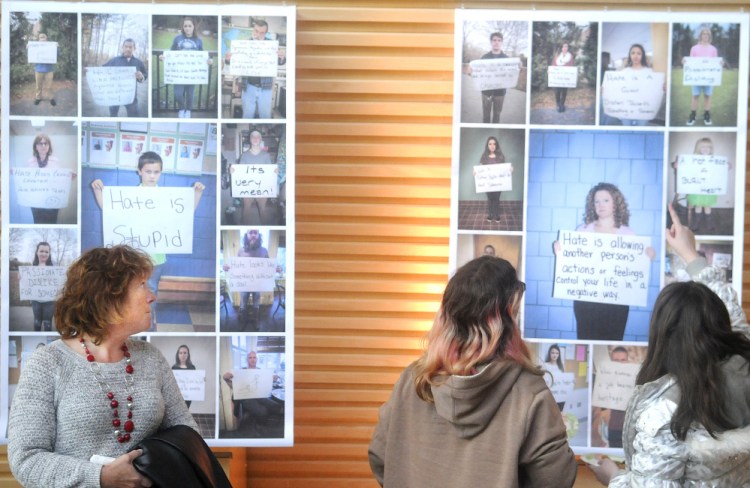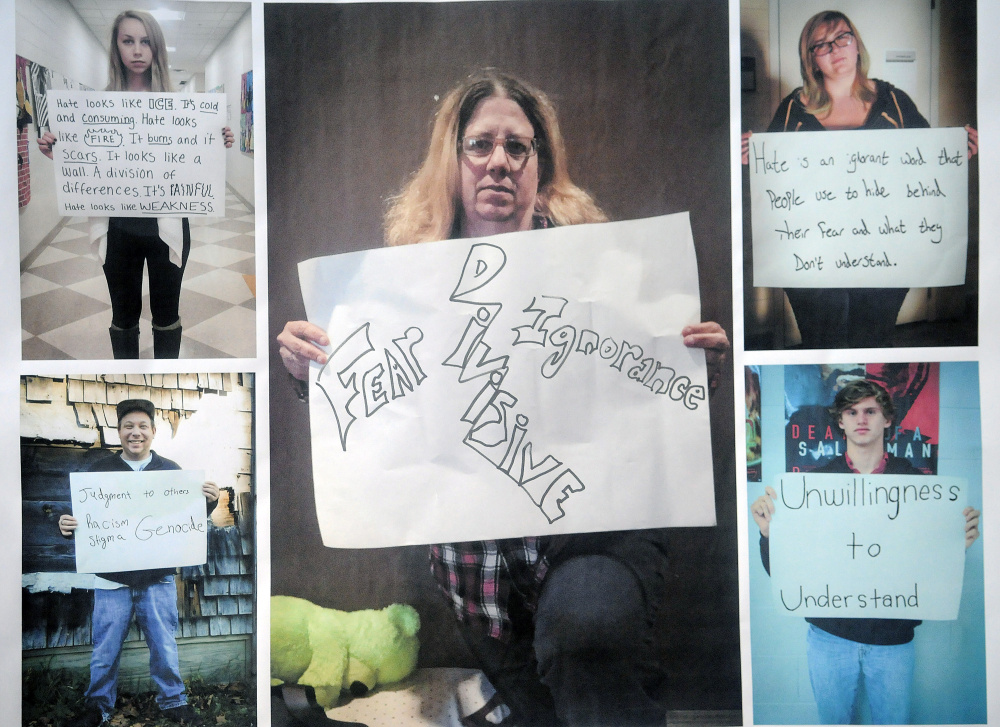AUGUSTA — Tanya von Aesch said she chose an African-American friend as a subject for her photography class project because of the hatred she faces daily. While walking down a busy street, von Aesch was stunned to see what that hate actually looked like to her friend.
“Hate looks like walking down Lisbon Street with (my friend) and having shops close because I was a white person walking with a black person,” von Aesch said. “It was so bad that an elderly Somali woman came out and said that it was rude and disrespectful of my friend to bring my son and me into the neighborhood.”
Photography students at Cony High School and the University of Maine at Augusta unveiled their “Sign Project” during a reception at the Holocaust and Human Rights Center of Maine Wednesday afternoon.
During the four-week project, 32 students from Cony and UMA explored the meaning of hate by interviewing and photographing friends, family and members of the community. Each of the 160 images featured a subject answering the question “What does hate look like?”
Cony junior Elliot Lagace said working on this project opened his eyes about hatred and how he could be more welcoming of others. His mom, Julia, also participated and said that the meaning of the word hate has changed since she was her son’s age, especially because of social media.
Von Aesch, a junior at UMA, experienced hatred on many levels. She was born in the U.S. but moved to Switzerland at a young age before moving back to the states.
“I ended up being called a foreigner in two different countries,” von Aesch said.
The Holocaust and Human Rights Center’s program director, David Greenham, said during his presentation that the project started a conversation about something that is hard to have a conversation about.
Much of the conversation centered on using education as a way to combat hatred. Kim Silsby, Cony’s principal of nearly three years, said her school is very welcoming and appreciative of its diversity, especially with a recent influx of students from Iraq.
“Why I chose to go into education is because I think (education) is the answer to a lot of society’s challenges,” Silsby said. “Once we are educated, we are able to make better decisions, and there are lots of new challenges when we have new students.”
Lagace said one of the ways she educates her children is by reminding them that they are immigrants and that their background is a mix of different ethnicities.
“Ultimately, I think that giving your children as much exposure to diversity, whether it’s in school, by traveling, by reading or using social media, is the best way to educate them,” Lagace said.
Robert Rainey, an associate professor of photography at UMA who is teaching the dual-enrollment course with Cony’s Jason Morgan, said he was impressed by how engaged the students and their families were throughout the project.
“It is amazing to have these Cony kids standing up to this issue,” Rainey said. “Being able to work with them and observe them every day was pretty impactful.”
After what Rainey said will be a needed break from the subject matter, Cony students plan to brainstorm solutions to the problems raised in the images. The students then will be photographed with their written solutions.
The pop-up exhibition will run through Nov. 30.
Jason Pafundi — 621-5663
Twitter: @jasonpafundiKJ
Send questions/comments to the editors.





Success. Please wait for the page to reload. If the page does not reload within 5 seconds, please refresh the page.
Enter your email and password to access comments.
Hi, to comment on stories you must . This profile is in addition to your subscription and website login.
Already have a commenting profile? .
Invalid username/password.
Please check your email to confirm and complete your registration.
Only subscribers are eligible to post comments. Please subscribe or login first for digital access. Here’s why.
Use the form below to reset your password. When you've submitted your account email, we will send an email with a reset code.